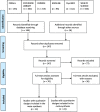Perceptions of insulin use in type 2 diabetes in primary care: a thematic synthesis
- PMID: 29788908
- PMCID: PMC5964885
- DOI: 10.1186/s12875-018-0753-2
Perceptions of insulin use in type 2 diabetes in primary care: a thematic synthesis
Abstract
Background: Increasing numbers of patients with type 2 diabetes mellitus are progressing to insulin therapy, and despite its potency many such individuals still have suboptimal glycaemic control. Insulin initiation and intensification is now often conducted by Practice Nurses and General Practitioners in many parts of the UK. Therefore, gaining insight into perspectives of patients and primary care clinicians is important in determining self-management and engagement with insulin. A thematic synthesis of studies was conducted exploring the views and experiences of people with type 2 diabetes and of healthcare professionals on insulin use and management in the context of primary care.
Methods: Protocol based systematic searches of electronic databases (CINAHL, Cochrane Library, EMBASE, MEDLINE, PsycINFO, and Web of Science) were performed on 1 October 2014 and updated on 31 March 2015, to identify studies that identified the views and experiences of adults with type 2 diabetes or primary care clinicians on the use of insulin in the management of type 2 diabetes. Studies meeting the review inclusion criteria were critically appraised using the CASP qualitative research checklist or Barley's checklist for survey designs. A thematic synthesis was then conducted of the collected studies.
Results: Thirty-four studies were selected. Of these, 12 used qualitative interviews (nine with patients and three with healthcare professionals) and 22 were survey based (14 with patients, three with healthcare professionals, and five with both). Twelve key themes were identified and formed three domains, patient perceptions, healthcare professional perceptions, and health professional-patient relationships. The patient-centred themes were: insulin-related beliefs, social influences, psychological factors, hypoglycaemia, and therapy barriers. The clinician-related themes were: insulin skills of general practitioners, healthcare integration, healthcare professional-perceived barriers, hypoglycaemia, and explanations for adherence. Healthcare professional-patient relationship themes were drawn from the perspectives of patients and from clinicians.
Conclusions: This review reveals multiple barriers to optimal insulin use in primary care at both the patient and healthcare professional levels. These barriers indicate the need for multimodal interventions to: improve the knowledge and competencies of primary care professionals in insulin use; provide more effective patient education and self-management support; and introduce integrated insulin support systems.
Keywords: General practice; Insulin; Patients; Perceptions; Primary care; Type 2 diabetes.
Conflict of interest statement
Authors’ information
KE is a PhD student at King’s College London.
HM is a lecturer at King’s College London.
AF is Chair of Clinical Diabetes Nursing at King’s College London
Ethics approval and consent to participate
This was not required as the data analysed were extracted from reports of previously published studies.
Competing interests
The authors declare that they have no competing interests.
Publisher’s Note
Springer Nature remains neutral with regard to jurisdictional claims in published maps and institutional affiliations.
Figures
Similar articles
-
Promoting and supporting self-management for adults living in the community with physical chronic illness: A systematic review of the effectiveness and meaningfulness of the patient-practitioner encounter.JBI Libr Syst Rev. 2009;7(13):492-582. doi: 10.11124/01938924-200907130-00001. JBI Libr Syst Rev. 2009. PMID: 27819974
-
Behavioural modification interventions for medically unexplained symptoms in primary care: systematic reviews and economic evaluation.Health Technol Assess. 2020 Sep;24(46):1-490. doi: 10.3310/hta24460. Health Technol Assess. 2020. PMID: 32975190 Free PMC article.
-
A qualitative study on healthcare professionals' perceived barriers to insulin initiation in a multi-ethnic population.BMC Fam Pract. 2012 Jul 4;13:28. doi: 10.1186/1471-2296-13-28. BMC Fam Pract. 2012. PMID: 22469132 Free PMC article.
-
Beyond the black stump: rapid reviews of health research issues affecting regional, rural and remote Australia.Med J Aust. 2020 Dec;213 Suppl 11:S3-S32.e1. doi: 10.5694/mja2.50881. Med J Aust. 2020. PMID: 33314144
-
Psychological interventions to improve self-management of type 1 and type 2 diabetes: a systematic review.Health Technol Assess. 2020 Jun;24(28):1-232. doi: 10.3310/hta24280. Health Technol Assess. 2020. PMID: 32568666 Free PMC article.
Cited by
-
Insulin therapy among diabetic patients in rural communities of Sub-Saharan Africa: a perspective review.Ther Adv Endocrinol Metab. 2024 Feb 19;15:20420188241232280. doi: 10.1177/20420188241232280. eCollection 2024. Ther Adv Endocrinol Metab. 2024. PMID: 38379780 Free PMC article. Review.
-
Insulin therapy in type 2 diabetes: Insights into clinical efficacy, patient-reported outcomes, and adherence challenges.World J Diabetes. 2024 May 15;15(5):828-852. doi: 10.4239/wjd.v15.i5.828. World J Diabetes. 2024. PMID: 38766443 Free PMC article. Review.
-
The diabetes insulin self-management education (DIME) intervention for people with type 2 diabetes starting insulin: a pilot feasibility randomised controlled trial.Pilot Feasibility Stud. 2023 May 26;9(1):89. doi: 10.1186/s40814-023-01318-x. Pilot Feasibility Stud. 2023. PMID: 37237318 Free PMC article.
-
A cross-sectional study evaluating insulin injection techniques and the impact of instructions from various healthcare professionals on insulin users in the southern region of Saudi Arabia.PeerJ. 2025 May 12;13:e19394. doi: 10.7717/peerj.19394. eCollection 2025. PeerJ. 2025. PMID: 40376558 Free PMC article.
-
Understanding Suboptimal Insulin Use in Type 1 and Type 2 Diabetes: A Cross-Sectional Survey of People with Diabetes.Patient Prefer Adherence. 2025 May 31;19:1625-1638. doi: 10.2147/PPA.S511332. eCollection 2025. Patient Prefer Adherence. 2025. PMID: 40476160 Free PMC article.
References
-
- Diabetes UK. Diabetes: facts and stats. 2016; https://www.diabetes.org.uk/. Accessed 19 Dec 2017.
-
- Evans ML, Sharplin P, Owens DR, Chamberlain GH, Longman AJ, McEwan P. Insulin usage in type 2 diabetes mellitus patients in UK clinical practice: a retrospective cohort-based analysis using the THIN database. British J Diab Vasc Dis. 2010;10(4):178–182. doi: 10.1177/1474651410370659. - DOI
-
- Mulnier H, Seaman H, Lovell D, Lawrenson R. The increasing proportion of patients with type 2 diabetes converting to insulin therapy. Practical Diabetes International. 2005;22(6):202–206. doi: 10.1002/pdi.815. - DOI
-
- Burden ML, Burden AC. Attitudes to starting insulin in primary care. Practical Diabetes International. 2007;24(7):346–350. doi: 10.1002/pdi.1142. - DOI
Publication types
MeSH terms
Substances
LinkOut - more resources
Full Text Sources
Other Literature Sources
Medical




